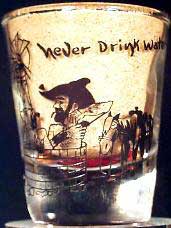 |
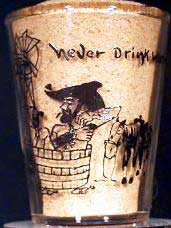 |
1950's |
1980's or 90's |
| Displays | Feedback | Links | Message Board | Shotglass Database | What Is A Shot Glass |
Sets That Change
One of the questions that I have asked other collectors is "Do we collect Glasses or do we collect Designs?" Another way to ask this question is "If you have a glass with a given design on it, and there is another glass of a different shape, but with the same design, would you buy the second glass?" Another question along the same vein: "If you already own a glass with a given design, and you find another with the same design, but the design is made of different colors, do you buy the second glass?" A third and final question: "If you have a glass with a given design, and you find a second glass with the same design, but the manufacturer of the two glasses are different, do you buy the second glass?"
The first question asks whether the shape of the glass matters. If I add the fact that the first glass was made 20 years before the second one, does this change your answer? One of the glasses in my collection was given to my parents in 1959. This glass has what I call the "standard" shape, with a top that is wider than its base, and the glass at the base is very thick. In 1993 on a roadtrip through Oklahoma, I found another glass with the same design, but although this glass was about the same shape as the first one, the glass of the base is about as thin as the walls. Also during this trip, I discovered that the manufacturer of these glasses was located in Sapulpa, Oklahoma. I also found out that the company still exists, and has a "factory outlet," which I visited. At the outlet, they did not have any glasses with designs, but they did have plain glasses with the same thin base and walls as the second glass, suggesting it is of fairly recent manufacture.
 |
 |
1950's |
1980's or 90's |
Color:
My second question asks if color matters. Again, I have glasses that have made me think about this question. There are a number of designs out there that are available in a "complex" color scheme and a "simple" color scheme. Although I cannot prove it, my assumption for this difference is cost. The original, multi-colored design cost too much to produce (takes too long, has too many rejects, etc.) so the colors are simplified (usually down to one) therefore making the glass easier and cheaper to produce. There is a group of glasses that go by the family name "Roving Eyes" (I say family name because there is more than one set of glasses within this family). The key feature to these glasses is that the characters painted on the outside have clear spaces where their eyes are, and the pupil and the white of the eye are actually painted on the inside of the glass. When you move the glass, the eyes seem to move. The original designs were made of two colors, plus the eyes inside. What I assume to be the next generation of these glasses has only a single color outside, plus the eyes inside. The third variation returns to two colors outside, but only the pupil of the eye is painted inside (no white). The final version of these glasses is a two color design outside, and while the eyes are still clear, the pupil is now placed on the outside of the glass.
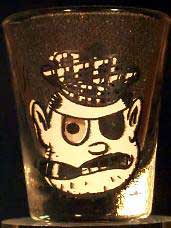 |
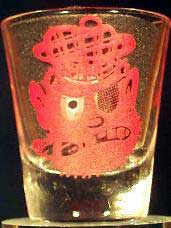 |
||
original |
single color |
no white |
pupil outside |
1) 880 2) 1241 1628 3) 2186
Manufacturer
For most glasses it is difficult to determine who made it unless there is a "makers mark" on the base. For shotglasses with designs on them, the mark on the bottom is not necessarily from the same company that produced the final product; If company A buys "plain" glasses from company B to use as the raw material for their "decorated" glass, there might be no way to identify company A as the producer of the final product. Another spin on this is where company B makes the whole product (including glass with company A's mark on the bottom) for company A. (I know this sounds a little complicated, but the example will use real names and hopefully clarify the situation).
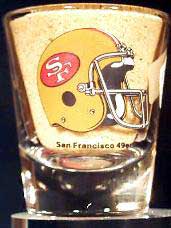 |
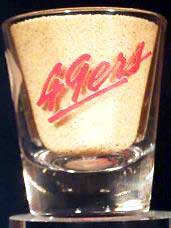 |
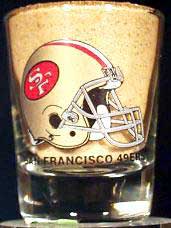 |
original (front) |
original (back) |
New |
The glasses from my collection that fall into this category are a group for professional football teams. (Some of the glasses from this group also fall into the first group, where the design has changed slightly over time.) The earliest versions of these glasses have a picture of the team's helmet above the name of the team, where the words of the name are in proper form (first letter of each word capitalized, the rest lower case). In addition, the team's name is written on the back of the glass in script letters. The next version of these glasses is missing the name on the back, and the name on the front has changed to all upper case letters. On at least some of the glasses, there is also a change in the style of the facemask on the helmet. The most recent change in these glasses is the "Maker's Mark" on the base of the glass. The newest ones say "Hunter Manufacturing" on the base. I think these glasses are actually manufactured by Libbey since I have purchased some of them at a Libbey Outlet Store. Most of the glasses that I have seen that are of the first two versions have the Libbey mark, which is a script L.
 |
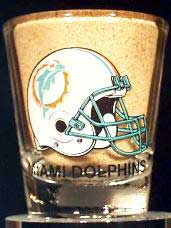 |
1989 |
1993 |
1) 2019 2) 73 3) 1613
With most collectables, the older item is worth more, but only if there is a way to tell the difference, between the two.
------------------------------------------------------